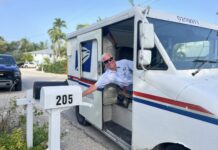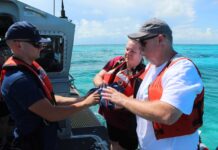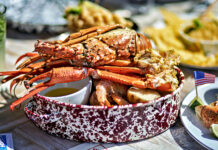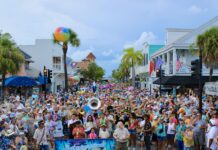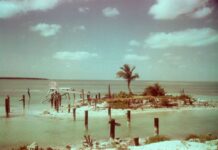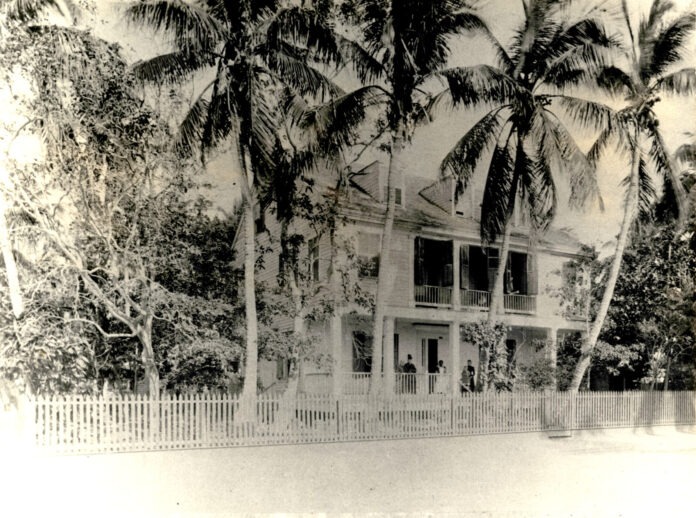
In the Lower Keys, near MM 12, Shark Key is announced by a building with a beautiful blue-tiled roof. The long, thin island sitting off to the right of the highway was developed in the 1980s as a private, upscale gated community. It is bigger than it was when the 1878 U.S. Coast Survey Chart No. 169 identified it as Shark Key.
The island is connected to the next one in the chain, Big Coppitt Key, by railroad fill created during the building of Henry Flagler’s Over-Sea Railroad. With a name like Big Coppitt Key, you might expect there to be a Little Coppitt Key or Middle-Sized Coppitt Key somewhere nearby, but there is just the not particularly large Big Coppitt Key. Why the fairly unusual name? While there does not appear to be anything definitive about the origin, it is thought to be derived from “coppice,” the English word for thicket.
Texas is home to the Big Thicket National Preserve (I camped there as a kid), so it is not like Big Coppitt (Thicket) Key is an outrageous choice for a name. The island is not a huge tourist draw and more of a locals’ destination. It is home to Bobalu’s Southern Café, a longtime local favorite, and a hyper-local watering hole known as the Purple Porpoise Pub — I’ve never been, but have always been curious about the dive bar.
Big Coppitt Key is also the gateway to Geiger Key. Shortly after crossing the railroad fill connecting Big Coppitt to Shark Key, a Circle K will appear on the left. However, immediately before the Circle K is Boca Chica Road, which is a highly recommended left turn. The road leads to Geiger Key.
There are two prevailing theories as to the name’s origin. One is that it was named for Captain John Huling Geiger, who served as a pilot for Commodore David Porter and his anti-piracy squadron when he sailed up to Key West in 1823. Geiger remained in the Keys long after Porter became a legendary memory and worked as one of the island’s wreckers, too.
It was on the back of the wrecking industry that Key West grew to become the richest city, per capita, in a growing United States. Stories told about the Florida wreckers, and the wrecking industry in general, have a habit of casting their “ilk” in the same category as pirates. As with every profession, there are bad apples. Not every lawyer, used car salesman or wrecker is, or was, out to rip you off. However, all it takes is a single example to cast a shadow — or a single white, furry blueberry to spread its spoil through an entire carton.
One aspect of their job was to sail up and down the Florida Reef in search of ships wrecked on the shoals and coral reefs. Often, they were the first responders of their day. Venturing into gale-force conditions was sometimes part of the job, even if occasionally men were washed overboard or were crushed between the colliding hulls of ships. The work was high-risk, but with that risk, sometimes, there were high salvage awards.
In every operation, the task was threefold: save the crew, save the cargo, save the boat.
When determining salvage fees for services rendered, several factors were considered, including manpower, weather and whether or not divers were needed to swim down into the holds of a bilging ship to secure cargo.
Geiger became a successful Florida wrecker and one of Key West’s wealthiest residents. He built a home befitting his growing family’s standing in the community. It stands, still, at the corner of Whitehead and Greene Streets. While the family occupied the house for more than a century, it fell into disrepair. In the 1950s, it was purchased by the Wolfson family, wired for electricity and restored to its previous glory. On March 18, 1960, they dedicated it as the Audubon House and offered it as a public museum.
The home’s connection to Audubon is tenuous. Some stories suggest that John James Audubon stayed there when he visited the Keys in 1832. However, the home was built after the 1846 Havana Hurricane ravaged Cuba, destroyed the Sand Key Lighthouse and delivered a double hurricane punch of high winds and tidal surge to Key West. Audubon was friendly with Geiger. It is said that one day, while standing in Geiger’s garden, he saw a tree and named Cordia sebestena the Geiger tree in honor of the captain.
It is a medium-sized tree with sticky leaves and stunning orange flowers. Other varieties produce white flowers or yellow flowers. When walking dogs, it is best to avoid letting them walk through piles of Geiger tree leaves, especially small dogs with long fur. I imagine cats are smart enough to avoid them, as I never see them walking around the neighborhood with leaves stuck to their fur.
Getting back to Geiger Key, the other story about the origin of the island’s name is that it was chosen because of the trees growing on it. In that case, the name also goes back to Geiger. In the notes of an 1861 Coast Survey conducted in the Keys, A.D. Bache wrote: “Geiger Key is 2 miles long and 1 mile wide. It was in good cultivation in 1855, and was inhabited by an industrious German, from whom it derived its name.”
When driving down the Overseas Highway, it’s always worth taking the turn immediately before the Circle K and driving down Boca Chica Road to Geiger Key, where you’ll find the not-so-hidden gem, the Geiger Key Fishing Camp. This is the perfect spot for some good food, cold drinks and waterfront views.
If not, there are only Rockland Key, Boca Chica and Stock Island before the highway comes to an end at MM 0 on Key West.




